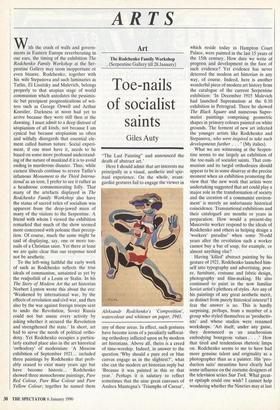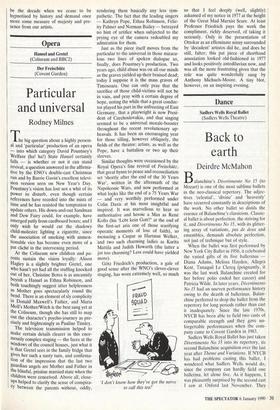ARTS
Art
The Rodchenko Family Workshop (Serpentine Gallery till 28 January)
Toe-nails of socialist saints
Giles Auty
With the crash of walls and govern- ments in Eastern Europe reverberating in our ears, the timing of the exhibition The Rodchenko Family Workshop at the Ser- pentine Gallery may seem inopportune or even bizarre. Rodchenko, together with his wife Stepanova and such luminaries as Tatlin, El Lissitzky and Malevich, belongs properly to that utopian stage of world communism which antedates the pessimis- tic but percipient prognostications of wri- ters such as George Orwell and Arthur Koestler. Darkness at noon had yet to arrive because they were still then at the dawning. I must admit to a deep distrust of utopianism of all kinds, not because I am cynical but because utopianism so often and wilfully disregards that essential ele- ment called human nature. Social experi- ment, if one must have it, needs to be based on some more profound understand- ing of the nature of mankind if it is to avoid ending in murderous disaster. Thus, while earnest liberals continue to revere Tatlin's infamous Monument to the Third Interna- tional as an icon, I prefer to see it rather as a headstone commemorating folly. That many of the artefacts displayed in The Rodchenko Family Workshop also have the status of sacred relics of socialism was apparent from the drop-jawed mien of many of the visitors to the Serpentine. A friend with whom I viewed the exhibition remarked that much of the show seemed more concerned with polemic than percep- tion. Of course, much the same might be said of displaying, say, one or more toe- nails of a Christian saint. Yet there at least we are quite clear that our response need not be aesthetic.
To the left-wing faithful the early work of such as Rodchenko reflects the true ideals of communism, untainted as yet by the realpolitik of a Lenin or Stalin. In his The Story of Modern Art the art historian Norbert Lynton wrote this about the era: 'Weakened by international war, by the effects of revolution and civil war, and then also by the war against foreign troops sent to undo the Revolution, Soviet Russia could not but assess every activity by asking whether it secured the Revolution and strengthened the state.' In short, art had to serve the needs of political ortho- doxy. Yet Rodchenko occupies a particu- larly exalted place also in the art historical 'orthodoxy' of modernism: 'A Moscow exhibition of September 1921... included three paintings by Rodchenko that prob- ably ceased to exist many years ago but have become historic... Rodchenko showed three monochrome paintings, Pure Red Colour, Pure Blue Colour and Pure Yellow Colour; together he named them "The Last Painting" and announced the death of abstract art,' Here I should admit that art interests me principally as a visual, aesthetic and spir- itual experience. On the whole, avant- gardist gestures fail to engage the viewer in Aleksaild r Rod Men ko's ' Composition' , watercolour and whitener on paper, 1943.
any of these areas. In effect, such gestures have become icons of a peculiarly suffocat- ing orthodoxy inflicted upon us by modern art historians. Above all, theirs is a creed of time-worship. Indeed, in answer to the question 'Why should a pure red or blue canvas engage us in the slightest?', what else can the modern art historian reply but 'Because it was painted in this or that year.' Perhaps it is salutary to reflect sometimes that the nine great canvases of Andrea Mantegna's 'Triumphs of Caesar', which reside today in Hampton Court Palace, were painted in the last 15 years of the 15th century. How dare we write of progress and development in the face of such evidence'? Yet evidence has never deterred the modern art historian in any way, of course. Indeed, here is another wonderful piece of modern art history from the catalogue of the current Serpentine exhibition: 'In December 1915 Malevich had launched Suprematism at the 0.10 exhibition in Petrograd. There he showed The Black Square and numerous Supre- matist paintings comprising geometric shapes in primary colours painted on white grounds. The ferment of new art infected the younger artists like Rodchenko and Stepanova, who were inspired to take such developments further . . ' (My italics).
What we are witnessing at the Serpen- tine seems to me largely an exhibition of the toe-nails of socialist saints. That com- munism and its turgid orthodoxies should appear to be in some disarray at the precise moment when an exhibition promoting the view that 'the new work that artists were undertaking suggested that art could play a major role in the transformation of society and the creation of a commtfnist environ- ment' is merely an unfortunate historical coincidence. Transnational exhibitions and their catalogue§ are months or years in preparation. How would a present-day Muscovite worker respond to the ideals of Rodchenko and others in helping design a `workers' paradise' when some 70-odd years after the revolution such a worker cannot buy a bar of soap, for example, or almost anything else?
Having 'killed' abstract painting by his gesture of 1921, Rodchenko launched him- self into typography and advertising, post- er, furniture, costume and fabric design, photography and film-making. He also continued to paint; in the now familiar Soviet artist's plethora of styles. Are any of his paintings of any great aesthetic merit, as distinct from purely historical interest? I fear the answer is no. This is hardly surprising, perhaps, from a member of a group who styled themselves as 'productiv- ists' and whose studios were renamed workshops. 'Art itself, under any guise, they denounced as an anachronism embodying bourgeois values . . .' How that tired and tendentious rhetoric limps on. Rodchenko seems to me to have had more genuine talent and originality as a photographer than as a painter, His 'pro- duction suits' meantime have clearly had some influence on the costume designers of the television series Star Trek. What great- er epitaph could one wish? I cannot help wondering whether the Nineties may at last
be the decade when we cease to be hypnotised by history and demand once more some measure of majesty and pre- sence from our artists.











































 Previous page
Previous page